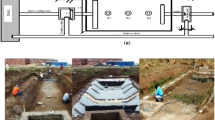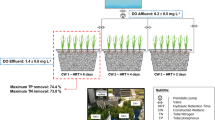Abstract
Conventional on-site wastewater treatment systems are no longer able to fully meet the needs of coping with the impacts of the variegated pollutants with which they are confronted. Without proper nitrification and denitrification, this implies a large fraction of nutrient loads such as nitrogen and phosphorus will flow into groundwater aquifers adversely affecting the water quality and public health. Constructed wetland, a cost-effective small-scale wastewater treatment system with low energy, maintenance requirements and operational costs may well fill the current gaps. In Phase I of this study, a subsurface constructed wetland system designed as an integral part of a performance-based passive on-site wastewater treatment system was proved effective after receiving septic wastewater flow. Using a suite of selected plant species, it is configured to handle 189 liters per day (50 GPD) of influent for a wastewater treatment and reuse study using green sorption media (recycled and natural materials) at a test center located at the University of Central Florida (UCF). During the three-month test run, the system achieved a removal efficiency of 75.4% in total nitrogen (TN) and 94.9% in total phosphorus (TP). Overall, the removal efficiency of TN and TP in an integrated septic tank and constructed wetland (ST/CW) system became as high as 81.3% and 95.8%, respectively.
Similar content being viewed by others
References
Billore SK, Sharmaj K, Dass P, Nelson R (1999) Horizontal subsurface flow gravel bed constructed wetland with Phragmites karka in Central India. Water Sci Technol 40(3):163–171
Braker G, Fesefeldt A, Witzel KP (1998) Development of PCR primer systems for amplification of nitrite reductase genes (nirK and nirS) to detect denitrifying bacteria in environmental samples. Appl Environ Microbiol 64:3769–3775
Brix H (1987) Treatment of wastewater in the rhizosphere of wetland plants—the root-zone method. Water Sci Technol 19:107–118
Campbell CL, Dawes PK, Deolakkar S, Merritt MC (1958) Effects of certain chemicals in water on the flavor of brewed coffee. Food Res 23:575–579
Chang NB, Wanielista M, Xuan Z, Shah TB, Hossain F (2009) Laboratory-scale characterization of the green sorption medium for wastewater treatment to improve nutrient removal. Environ Eng Sci (in review)
Comly HH (1945) Cyanosis in infants caused by nitrates in well water. J Am Med Assoc 192(2):112–116
Cooper PF, Findlater BC (eds) (1990) Constructed wetlands in water pollution control. In: Proceedings of the international conference on the use of constructed wetlands in water pollution co (advances in water pollution control). Pergamon Press, London
Dieter HH, Möller R (1991) Ammonium. In: Aurand K et al. (eds) Die Trinkwasserverordnung, Einführung und Erläuterungen. Erich-Schmidt, Berlin, pp 362–368
Forman D, Al-Dabbagh S, Doll R (1985) Nitrates, nitrites and gastric cancer in Great Britain. Nature 313:620–625
Fraser P, Chilvers C, Beral V, Hill MJ (1980) Nitrate and human cancer: a review of the evidence. Int J Epidemiol 9(1):3–11
Hossain F, Chang NB, Wanielista M, Xuan ZM, Makkeasorn A (2009) Nitrification and denitrification effect in a passive on-site wastewater treatment system with a recirculation filtration tank. J Water Qual Expo Health (in review)
Kadlec R, Knight R, Vymazal J, Brix H, Cooper P, Haberl R (2000) Constructed wetlands for pollution control: processes, performance, design and operation [M]. Scientific and Technical Report No. 8. London, UK
Kickuth R (1977) Degradation and incorporation of nutrients from rural wastewaters by plant rhizosphere under limnic conditions. In: Utilization of manure by land spreading. Comm Eur Commun, EUR 5672e, London, pp 335–343
Korkusuz A, Beklioğlu M, Demirer GN (2007) Use of blast furnace granulated slag as a substrate in vertical flow reed beds: field application. Bioresour Technol 98:2089–2101
Mann RA, Bavor HJ (1993) Phosphorus removal in constructed wetlands using gravel and industrial waste substrata. Water Sci Technol 27(1):107–113
Mbuligwe SE (2005) Applicability of a septic tank/engineered wetland coupled system in the treatment and recycling of wastewater from a small community. Environ Manag 35(1):99–108
Mirvish SS (1991) The significance for human health of nitrate, nitrite, and n-nitroso compounds. In: Bogardi I et al. (eds) Nitrate contamination: exposure, consequence, and control. NATO ASI series, vol G30. Springer, Berlin
Obarska-Pempkowiak H, Ozimek T (2000) Efficiency of wastewater treatment in an improved constructed wetland. Pol Arch Hydrobiol 47(2):247–256
Park WH, Polprasert C (2008) Roles of oyster shells in an integrated constructed wetland system designed for P removal. Ecol Eng 34:50–56
Rivera F, Warren A, Curds CR, Robles E, Gutierrez A, Gallegos E, Calderon A (1997) The application of the root zone method for the treatment and reuse of high-strength abattoir waste in Mexico. Water Sci Technol 35(5):271–278
Ryan P, Wanielista M, Chang NB (2009) Reducing nutrient concentrations from a stormwater wet pond using a chamber upflow filter and skimmer (CUFS) with green sorption media. Water, Air Soil Pollut. doi:10.1007/s11270-009-0174-x
Sattelmacher PG (1962) Methemoglobinemia from nitrates in drinking water. In: Schriftenreihe des Vereins fur Wasser, Boden und Lufthygiene. Gustav Fischer Verlag, Stuttgart
Seidel K (1955) Die Flechtbinse, Scirpus lacustris L. Oekologie, Morphologie und Entwicklung, ihre Stellung bei den Völkern und ihre wirtschaftliche Bedeutung. Sweizerbart’sche Verlagsbuchhandlung, Stuttgart, pp 37–52
Seo DC, DeLaune RD, Park WY, Lim JS, Seo JY, Lee DJ, Cho JS, Heo JS (2009) Evaluation of a hybrid constructed wetland for treating domestic sewage from individual housing units surrounding agricultural villages in South Korea. J Environ Monit 11(1):134–144
Sonia H, Baudoin E, López-Gutiérrez JC, Martin-Laurent F, Brauman A, Philippot L (2004) Quantification of denitrifying bacteria in soils by nirK gene targeted real-time PCR. J Microbiol Meth 59:327–335
Steer D, Fraser L, Boddy J, Seibert B (2002) Efficiency of small constructed wetlands for subsurface treatment of single-family domestic effluent. Ecol Eng 18:429–440
Surrency D (1993) Evaluation of aquatic plants for constructed wetlands. In: Moshiri GA (ed) Constructed wetlands for water quality improvement. Lewis, Boca Raton, pp 349–357
Tee HC, Seng CE, Noor A, Lim PE (2009) Performance comparison of constructed wetlands with gravel- and rice husk-based media for phenol and nitrogen removal. Sci Total Environ 407:3563–3571
United States Environmental Protection Agency (USEPA) (2003) Voluntary National Guidelines for Management of Onsite and Clustered (Decentralized) Wastewater Treatment Systems, EPA832-B-03-001
van Maanen JMS, Dijk A, Mulder K, de Baets MH, Menheere PCA, van der Heide D, Mertens PLJM, Kleinjans JCS (1994) Consumption of drinking water with high nitrate levels causes hypertrophy of the thyroid. Toxicol Lett 72:365–374
Walton B (1951) Survey of the literature relating to infant methemoglobinemia due to nitrate contaminated water. Am J Public Health 41:986
Watson JT, Choate KD, Steiner GR (1990) Performance of constructed wetland treatment systems at Benton, Hardin, and Pembroke, Kentucky, during the early vegetation establishment phase. In: Cooper PF, Findlater BC (eds) Constructed wetlands in water pollution control. Pergamon Press, Oxford, pp 171–182
Yang Y, Xu Z, Hu K, Wang J, Wang G (1995) Removal efficiency of the constructed wetland wastewater treatment system at Bainikeng, Shenzhen. Water Sci Technol 32(3):31–40
Author information
Authors and Affiliations
Corresponding author
Rights and permissions
About this article
Cite this article
Xuan, Z., Chang, NB., Daranpob, A. et al. Initial Test of a Subsurface Constructed Wetland with Green Sorption Media for Nutrient Removal in On-site Wastewater Treatment Systems. Water Expo. Health 1, 159–169 (2009). https://doi.org/10.1007/s12403-009-0015-6
Received:
Revised:
Accepted:
Published:
Issue Date:
DOI: https://doi.org/10.1007/s12403-009-0015-6




